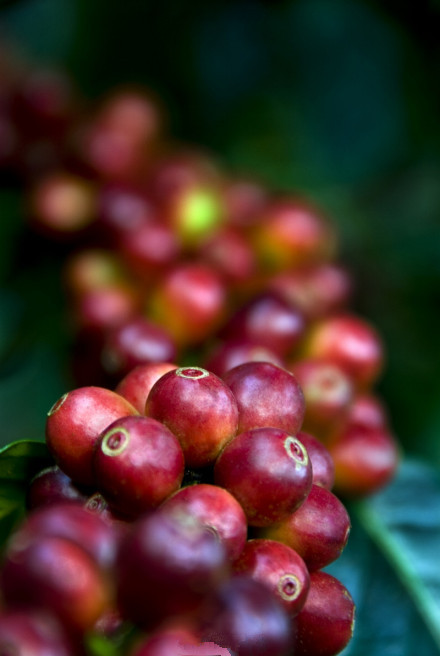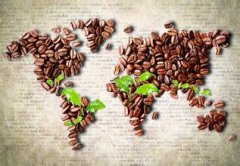Planting and Distribution of Coffee trees with Comprehensive knowledge of Coffee

Distribution of coffee:
Coffee trees grow in national gardens in tropical or subtropical regions with the equator as the center and between latitudes 25 degrees south and north, called the coffee belt. At present, coffee is produced in more than 60 countries, widely distributed in South America, Central America, the West Indies, Asia, Africa, Arabia, the South Pacific and Oceania. In terms of production, Brazil, which accounts for the largest output in the world, accounts for about 30%; the second is Central and South America, which is centered on Colombia (10%), accounting for 60%; followed by Africa and Arabia, accounting for about 30%; the remaining 10% are distributed in Asia and most islands.
The growth habits of coffee:
Coffee trees belong to the evergreen family of Akanaceae. They are tropical plants that are not cold. Most of them are planted in areas with elevations of 300,400m, and also in highlands with elevations of 2000-2500 meters. But those who plant on slopes above 1500 meters above sea level have better quality. Coffee trees are most suitable for growing in an environment where the average temperature is about 20 degrees Celsius, annual precipitation is 1500-2000 mm, soil permeability is strong, and sunshine is suitable. Coffee is afraid of Frosts Descent and the cold winter, and must not be planted in the highlands where frost falls. Generally speaking, wild coffee trees can grow to about 8 meters. They are planted at home. In order to protect the quality of coffee beans, facilitate management and harvest, the height is cut to 2 meters. Coffee beans begin to bear fruit 3-5 years after sowing, and 5-20 years is the harvest period. A coffee tree can produce about 3-5 kilograms of coffee cherries per year.
Planting and Distribution of Coffee trees
The origin of the coffee tree is Ethiopia in Africa. In botany, coffee trees belong to the evergreen trees of the subgenus Rubiaceae, and coffee beans, commonly known as coffee beans, are actually the seeds of the fruit of coffee trees. They are called coffee beans only because they are shaped like beans. Climate is the decisive factor for coffee cultivation. Coffee trees are only suitable for growing in the tropics or subtropics, so the zone between latitude 25 degrees south and north is generally called coffee belt or coffee area. However, not all the land located in this area can produce good coffee trees.
Planting conditions of Coffee trees
The ideal planting conditions for coffee trees are: the temperature is between 15 degrees and 25 degrees, and the annual rainfall must reach 1500 mm to 2000 mm. At the same time, the rainfall time should be in line with the flowering cycle of coffee trees. Of course, in addition to the seasonal rainfall, there should also be fertile soil and good drainage.
Fertile soil containing volcanic ash, in addition, although sunlight is an indispensable element for the growth and fruit of coffee, too strong sunlight will inhibit the growth of coffee trees, so various producing areas usually cooperate with the planting of some shade trees. The ideal altitude is 500m-2000 m above sea level. It can be seen that the conditions for the cultivation of high-quality coffee are quite strict: sunlight, rainfall, soil, air temperature, as well as the way coffee beans are harvested and the production process will affect the quality of coffee itself.
White flowers, red fruits.
The first flowering period of the coffee tree is about three years old. the five-petal tube-shaped white flowers are filled with a faint scent of jasmine and the inflorescences are arranged in dense clusters.
Flowers wither after two or three days of blooming and begin to bear fruit after a few months. The fruit is a drupe with a diameter of about 1.5cm. It turns green at first, then turns yellow gradually, and turns red when ripe. It is very similar to cherries, so it is called cherry coffee (Coffee Cherry). It can be harvested at this time.
Coffee fruit contains two seeds, namely coffee beans. The two beans are connected face to face with each other on one side of the plane. Each coffee bean has a thin outer film, which is called silver skin, and its outer layer is covered with a yellow outer skin, called endocarp. The whole coffee bean is wrapped in a sticky pulp to form the coffee pulp, which is soft and sweet, with the outer shell. Coffee beans are the seeds of coffee cherries. Every winter (dry season) is the harvest time, and there are many ways to harvest red cherries. The bean itself is wrapped in many layers of material, including a silver skin, pergamino-like paper, mucus, mucilage, and its watch case. The interaction between these sweet, sticky substances and the coffee bean itself determines the taste of many coffee beans; the same method is used when the coffee bean is removed from the cherry. Basically, there are three ways to treat coffee beans: wet, dry and semi-wet and semi-dry.
As soon as coffee cherries are picked, they have to be sent to agricultural products for processing. Cherries that have been picked, including freshly ripe, overripe, and unripe, are all mixed together. If these cherries are not treated separately, the quality of the coffee beans is really unpalatable, because it is mixed with a lot of bad-tasting impurities. So these cherries have to be washed and placed in a large trough full of water for preliminary classification. The best coffee has a high density, so it sinks into the water. On the other hand, overripe cherries will surface and can be easily classified. Low-quality coffee is either left for internal consumption or sold to instant coffee producers in the United States or Europe. Unfortunately, those unripe cherries will also sink to the bottom of the water and mingle with those that are already ripe. So cherries that are not yet ripe should be treated with moisture, or it may take a while to use drying to sort them.
In the process of wet treatment, ripe cherries will be squeezed out of the juice. If handled properly, only ripe cherries will be squeezed out of the pulp, and unripe hard cherries will be distinguished. The beans should be sent to the fermentation tank and soaked in water for about 8-20 hours.
At this time, the sticky liquid in the coffee beans has been filtered out. Coffee beans produced by wet treatment are characterized by bright and clean taste. But compared with the coffee beans produced by drying, they are not so fragrant and strong. When the mucus is removed from the fermentation tank, the coffee is either left on the terrace to dry naturally, or dried by machine, or both. Almost all coffee producing areas are treated mainly by drying, because the difference between coffee beans produced by this method is very small. The main purpose of this treatment is to prevent the beans from fermenting so that the coffee beans do not produce mold with an abominable taste of wet soft fruit.
If the wet treatment method is not used, the drying method (natural treatment) can be used because the weather conditions in some areas are suitable for manufacturers. After the cherry seeds split inside, especially after the sticky substance is removed, coffee beans can be simply dried, dried on a large terrace or dried by machine. Using this method, it takes a little longer and is easier to ferment. In any case, because dried coffee beans always come into contact with sweet mucus for a long time, so processed coffee beans will be sweeter and heavier. The acidity, cleanliness, and taste of coffee usually disappear during processing. Coffee beans that are naturally treated are usually used to make espresso (espresso).
The third method called semi-wet treatment (natural removal of pulp) is a relatively new and rare method. This method is also suitable for processing local coffee only in specific areas of some countries where there is a long drying period in the climate. The coffee produced by this method is sticky, and the mucus is not removed with fermentation in the tank. Therefore, the coffee produced by this semi-wet treatment contains the characteristics of both wet treatment and drying treatment. The acidity, sweetness, seasoning, and flavor of such coffee are quite good; the only thing is that such coffee is not as strong as coffee produced by pure dry or wet treatment. When the coffee bean is dry, put it in a rattan frame with a vine shed as the top. It is not opened until a shelling program is operated before it is shipped out. The purpose of this is to keep the flavor and taste of the coffee intact. After shelling, the coffee beans, in 60 kilograms, are packed in a burlap bag, ready for export.
Next, the importers of the coffee will send the coffee to the manufacturers in the country for baking. The roasting of coffee is the most important process for the development of its own flavor. The flavor of coffee itself also changes its taste, bean body, aroma, and acidity as it is roasted. Light roasting produces many flavors, aromas, and acidity, while heavy roasting produces thicker beans and brews a more intriguing cup of coffee. It is a pity that heavy-roasted coffee is basically to stabilize the quality of coffee beans, so it is difficult to hide the defects of coffee beans.
After roasting, coffee beans can be prepared and cooked in a variety of ways; some are cooked by espresso machines, or by French pressing, in vacuum pots, by dripping, and so on. And a variety of different cooking methods are to grind the coffee beans into different coarse and fine particles. Since coffee is easy to lose fresh products, the most important technique for grinding coffee is to drink as much as you can. At present, there is no kind of packaging on the market to preserve the taste of ground coffee powder.
The taste of coffee itself is quite controlled by the way it is brewed. The coffee brewed with Espresso has a heavy taste, a strong flavor and a complicated process. On the other hand, the coffee brewed with dripping water is cleaner and brighter, and retains more original flavor. French compressed brewed coffee retains almost all the original flavor, as well as the unique complexity of the coffee itself, but the acidity is slightly missing. If you use a vacuum pot to brew the coffee, it is clean and the flavor is fully preserved. In fact, if every cooking method is to taste good, the most important thing is the right temperature and time.
At present, there are more than 60 coffee-producing countries, most of which are located in areas with an altitude of 300 to 400 meters above sea level, and they are also cultivated in highlands with elevations of 2000 to 2500 meters, among which those planted on hillsides above 1500 meters have the best quality.
Coffee trees generally grow in tropical and subtropical areas with an annual rainfall of 1500 to 2000 mm and an average temperature of 20 degrees. The main tree species are Arabian, Robusta and Libyan. Even in the same production country, the coffee beans will have their own characteristics due to the differences in flavor and quality due to the different climate, altitude and soil quality of different regions. Therefore, it is difficult to describe the characteristics of a country's coffee beans in one sentence.
The way of making coffee beans
Washing type: put the harvested fruit in the sink, remove the gum from the pulp and epidermis and dry it through the friction of water and utensils. The coffee beans obtained by this method have better color, less impurities and uniform quality. This method has been adopted in Colombia, Mexico, Guatemala and other countries.
Sun style: put the harvested fruit in the sun for one to two weeks, let it dry naturally, and then use a sheller to remove the pulp and peel. The coffee beans will be slightly sour and slightly bitter, but are more easily affected by the weather. Almost all coffee beans in Brazil, Ethiopia, Yemen and other places are obtained in this way.
There are generally two seed pairs composed of oval seeds in the fruit of flat bean and round bean coffee, and their connecting side is flat, which is called flat bean, but there is only one round seed in some fruit, which is called round bean. They don't taste different.
Important Notice :
前街咖啡 FrontStreet Coffee has moved to new addredd:
FrontStreet Coffee Address: 315,Donghua East Road,GuangZhou
Tel:020 38364473
- Prev

Coffee slimming tips for slimming coffee don't add sugar
As a member of OL, you are no stranger to coffee culture, are you? Within 30 minutes to 1 hour after lunch, taste a full-bodied cup of coffee without sugar and partner, which helps digestion after meals and promotes fat burning. Before getting off work, have another cup of coffee and go for a walk. Tips for slimming Coffee Don't add sugar: if you're not used to the bitterness of coffee, you can add a little milk, but thousands
- Next

The original varieties of coffee beans are mainly from Arabica.
At present, the most important coffee beans in the world mainly come from three original varieties: Arabica, Roberta and Liberia. The Arabica coffee tree, which originated in Ethiopia, accounts for 70% of the world's coffee production, and almost all the world-famous coffee varieties are Arabica species. Arabica coffee trees are suitable for growing in high mountains with large temperature difference between day and night, as well as low humidity and good drainage.
Related
- Beginners will see the "Coffee pull flower" guide!
- What is the difference between ice blog purified milk and ordinary milk coffee?
- Why is the Philippines the largest producer of crops in Liberia?
- For coffee extraction, should the fine powder be retained?
- How does extracted espresso fill pressed powder? How much strength does it take to press the powder?
- How to make jasmine cold extract coffee? Is the jasmine + latte good?
- Will this little toy really make the coffee taste better? How does Lily Drip affect coffee extraction?
- Will the action of slapping the filter cup also affect coffee extraction?
- What's the difference between powder-to-water ratio and powder-to-liquid ratio?
- What is the Ethiopian local species? What does it have to do with Heirloom native species?

